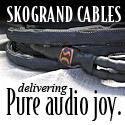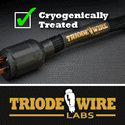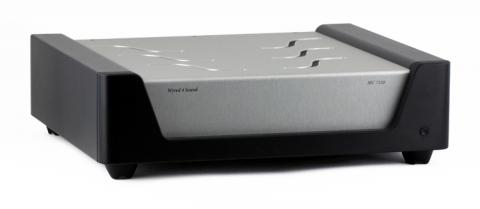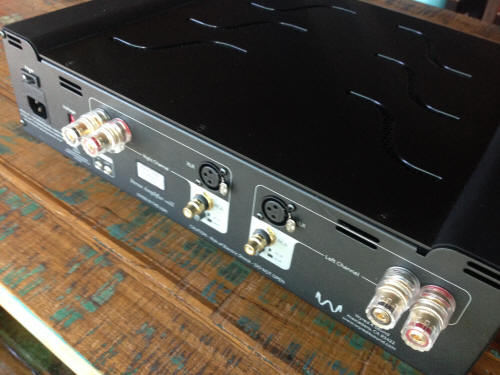|
|
You are reading the older HTML site
Positive Feedback ISSUE 73
wyred 4 sound ST-1000 mkII Stereo Amplifier as reviewed by Michael Wechsberg
About Class-D Amplification One of the brands I see often around recent audio shows is Wyred 4 Sound. It seems their products work well with a broad spectrum of complementary speaker and source components, so partners seek them out for show exhibits. Best known (to me anyway) for their DACs and headphone amps (the DAC2 is a very credible high-end performer at only $1599), the California company started out in 2007 making amplifiers and established itself with a line of class-D amplifiers that were small, efficient, affordable, and smooth sounding. Since so-called digital amplifiers have been a hard sell to audiophile types, it’s rather amazing that a small company dedicated mainly to 2-channel audio would do so well with such amplifiers, but the key to sales has been the good sound emanating from the Wyred 4 Sound amps, preamps, DACs, and music servers. The ST-1000 mkII Stereo Amplifier is one of the latest designs from Wyred, and it's a real powerhouse packing 460 Watts per channel into 8 ohms, and a spectacular 723 Watts per channel into 4 ohms (both figures with THD + noise of < 0.2%). This is the biggest and baddest amplifier in the Wyred line and represents their current statement in high-end amplification. Yet, the price is only $1999! Kinda reminds me of the old Phase Linear 700 amplifier from Bob Carver back in the 1970’s (it ran for $749 back then according to the Phase Linear amplifier history site). I thought the ST-1000 sounded great in the demo rooms at the audio shows and I wanted to sample the current state of class-D amplifier art in my own home, so I asked Wyred 4 Sound for a review copy. Those of you who follow my reviews in PF may recall that I have a background in electrical engineering, but I don’t work in the audio field. I’m not swayed by the arguments of some who believe class-D amplification is hopelessly flawed, but neither am I convinced by those who claim using mathematics that such amps sound just as well as the more conventional class A or A/B amplifiers, while providing better efficiency, ergonomics and lower cost. I’m guided by what my ears hear, but I do try to understand the why of what I’m hearing.
Over the years I have had a number of so-called digital amplifiers pass through my sound system. While none were terrible, they all had flaws that made them hard to recommend for long-term residence in PF reader systems. That is, until I heard the most recent example of a digital power amplifier to come to my attention, the AURALiC MERAK monoblock (see review in Issue 70). This amplifier uses the Hypex class-D amplifier circuit from the Netherlands, and delivers an extremely clear and powerful sound that has spot-on tonality and lushness that I hear seldom in amplifiers under $10,000. The MERAKs gave my reference EAR 890 a run for its money and costs a relatively affordable $5000/pair, delivering 200 Watts per channel into 8 ohms, and 400 Watts into 4 ohms. The AURALiC amp is not a pure class-D design, but more of a hybrid. It uses a linear power supply instead of a switching power supply (a really excellent power supply I might add, with very high quality parts) and a custom transformer-coupled low-noise input amplifier of their own design. Only the output stage of the Hypex circuit is used (the switching transistor). The MERAK is put together overseas (Taiwan I believe), but uses parts sourced from all over the world. It also has really beautiful casework and prime workmanship all around. Based on this positive experience with the MERAKs I was anxious to hear what the Wyred 4 Sound amp could do. It puts out about twice as much power for less than half the money, and fits into a single chassis instead of two.
Wyred 4 Sound Arrives The ST-1000 mkII comprises a pair of ICEpower® class-D amplifier modules, sourced from Bang & Olufsen in Denmark, installed in a single aluminum chassis. Wyred says they use the amplifier modules without modification, including integral switching power supplies, but use their own design for the input buffer, chassis, inputs/outputs and mechanical features. The chassis is designed to be rigid and to damp vibration, and includes four compliant footers on the bottom. Good quality input and output connectors are supplied. The amplifier accepts both single-ended and balanced inputs, selected by a small push button adjacent to each RCA connector. The input impedance is 92kohms in either balanced or unbalanced mode. Wyred’s input buffer has 6dB of gain that is used to advantage to lower the noise floor of the amp and increase dynamic range. They tune the buffer stage to give a characteristic "Wyred" sound. Although the output connectors are decent, I had trouble getting a firm connection with some speaker cables that had large spade lugs. Banana plugs would have solved this, but I misplaced the ones I normally use, so they were not available. Wyred can supply the amp with upgraded output terminals for a small upcharge. The rear panel also has terminations for a 12V DC trigger and a 115V/230V voltage selector. There is a power switch and IEC power connector on the rear. Wyred supplies the amplifier with a typical commercial power cord, but I did not use it, instead favoring the Kubala-Sosna Emotion power cord I use with my reference amp. Switching the rear panel power switch to "on" places the unit into standby mode, where it consumes about 0.5W. This produces a ring of green light around the front-panel power push button. Pressing this button changes the light to blue indicating the amp is ready to go. Some of the other specifications include: typical THD of 0.001%, output impedance of 0.21 ohms, input sensitivity of 1.75V, 3dB bandwidth at 1W output of 1.5Hz to >70kHz, maximum output current of 30A and dynamic range of 108dB.
The inside of the ST-1000 is quite roomy, almost like Wyred did not want to make the amplifier too small because of its high power capability. The two ICEpower® circuit boards with integral power supplies dominate the interior. Two smaller circuit boards are mounted to the rear panel for the Wyred input circuit. The layout is neat and the workmanship appears to be of high quality. I should mention that although the ICEpower® boards come from abroad, the rest of the amplifier is assembled in the USA—in California no less. I think if Wyred had gone to Asia to assemble the amplifiers, there would not be a huge cost impact because most of the labor is in the ICEpower® boards that come pre-assembled (not sure where B&O makes these). From a parts-and-workmanship standpoint, the ST-1000 seems appropriately priced. Wyred also carries a lower power amplifier that is the same size, the ST-500 mkII, that outputs a little more than half the power of the ST-1000 for $500 less. They also carry the SX series of high power monoblock amplifiers in smaller chassis that go for $899 to $1199. All in all, a good line of high power amps at affordable prices. Listening Notes To evaluate the sound of the ST-1000 I dropped it into my reference setup in place of the mighty 70W/ch E.A.R. 890 stereo amplifier. Speakers were the Marten Django XLs that are relatively efficient and a pretty easy load, averaging around 6 ohms. My room is fairly large (30 ft x 22 ft) but has low 8 foot ceilings, and I sit pretty close to the speakers. It is unlikely these speakers could test the full power output of this amplifier, but they are very revealing. Speaker cables were the Kubala-Sosna Emotions for most of the listening. The preamp was the E.A.R. 868 and my CD/DAC is the E.A.R. Acute III. My turntable system was going through some changes during this review period, so I did not spin LPs while evaluating the ST-1000. I used mostly CDs and some hi-rez downloads for my listening tests. Interconnects were all Kubala-Sosna Elation balanced cables, and I used the K-S Emotion power cord that I normally use with the E.A.R. 890. All power cords were plugged into the Wywires Power Broker, which in turn was plugged into my dedicated AC line. As supplied, the ST-1000 had about 100 hours of break-in at the factory before it was sent to me. I was advised that another 100 hours would bring the amplifier up to its optimum level. So, I played it for a few days in the background and left it on for over a week before beginning serious listening. Even right out of the box the ST-1000 impressed with its very dynamic and clean sound. During the break in period I noticed improvements in soundstaging and low-end reach, but no significant change in tonality. Most audiophiles who acquire a high power amplifier tend to want to push the limits, and I admit I did the same. While the ST-1000 was in house I think I played everything louder than I normally do, just because of the power specifications. I doubt the amplifier was straining at all, and because the class-D amp is so efficient; the chassis temperature barely rose by a couple of degrees from ambient. The ST-1000 does do dynamics well, and needless to say, I never heard any congestion or distortion when playing at high levels. It is a very quiet amplifier and has plenty of headroom, plus the bandwidth for it to sound very fast when the music requires. I was also impressed by the very broad soundstage portrayed by this amp. The image was set a little further back than I’m used to with my reference amp, and seems to go a bit deeper. The overall musical presentation was fluid and rich. The high end, which is often a problem with class D amplifiers, was quite smooth and lovely. The tube preamp and my choice of cables might have contributed to this. Certainly the ST-1000 has the resolution to make cable differences discernable, so I don’t recommend you skimp on cables if you chose to add the Wyred amp to your system. On the other hand the ST-1000 did not have the transparency and definition in the high frequencies that comes with more expensive amplifiers. However, I was using speakers and ancillary equipment priced much higher than the amp. In a more appropriately balanced system, as heard at the recent audio shows, I don’t think this effect will be heard. The ST-1000 excelled in the ever-important midrange. Here the tonal colors were brilliant, and I heard plenty of detail and definition. Female vocalists were glorious through this amp, and so was most jazz and classical music I tried. In fact I binged on female vocalists while I was evaluating the ST-1000, even though I’ve long since gotten over most of the girl singers in my collection, as they are used extensively in my reviewing work. I managed to find some I hadn’t listened to in a while, or at all yet, and playing them through the ST-1000, which made me very happy. Music also had great rhythmic drive that was very involving. This is a characteristic I find very important for my musical enjoyment, and some equipment just doesn’t have it. The ST-1000 does, and you have to go up in price quite a bit to better it. By the way, I did not play everything loud while I had the ST-1000 in the house. At normal and low levels the amp retained its basic sterling qualities, including the midrange resolution that is a strong point. I also found the low bass to be especially grand with the ST-1000. Deep and tight, in fact better than my reference E.A.R. amp. This part of the frequency range has always been a strong point for class-D amps (actually for solid state in general compared to tubes). On the other hand, I found the ST-1000 to be a bit thin through the mid-bass compared to my reference amp and other recent amps I’ve had in house (including the AURALiC MERAKs). Other class-D amps I’ve heard tend to have a bit too much bass for my taste. In fact I’ve always thought this was why they were used so successfully to power subwoofers and in home theater installations. The ST-1000 seems to be tuned to mitigate this, without sacrificing the very deep bass response. However, it detracted from the sound of many male vocalists (even tenors) making their chest tones sound lackluster, and it dropped some instruments, such as the piano, deeper into the sound mix. I tried changing speaker cables to mitigate this effect, but the two other sets I had on hand did not change this part of the frequency range. It could be that the ICEpower® amplifier is not working optimally into the speaker load of my Marten speakers (I’ve noted some comments about this sort of thing online while reading about the ICEpower® amps). I didn’t hear this with the MERAKs that use the Hypex class-D circuit playing through the same cables and speakers. I also did not notice this when I listened to the Wyred amps at the recent audio shows. The logical advice here is "try before you buy" using your own speakers to make sure you are satisfied with the sound of the ST-1000. Conclusion Overall, I find the Wyred 4 Sound ST-1000 mkII to be a real bargain in audio at $1999. It provides a zillion watts so you can use it in large rooms even with inefficient speakers to hear rock music at concert levels. I expect it would handle difficult loads from ribbon or planar speakers with aplomb. At the same time small ensembles or slow moody vocals played at low levels are handled with delicacy and charm. The important midrange is to die for and it has great dynamics and drive. Put one of these on your shopping list when next you are in the market for a new power amplifier. Michael Wechsberg
ST-1000 mkII amplifier
Wyred 4 Sound
|












